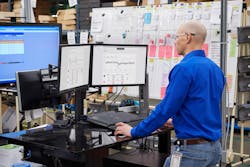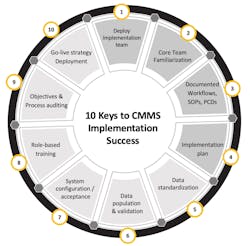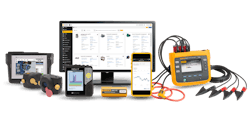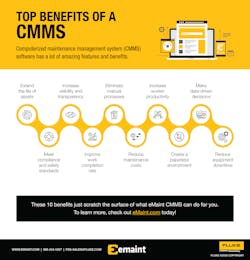10 Key Steps to CMMS Implementation Success
Have you ever bought something and decided you could "wing it" and put it together or operate it without reading the instructions? This often results in a partially or poorly functioning product or a do-over that involves going back and reading the directions.
Unfortunately, a similar scenario often applies to computerized maintenance management system (CMMS) software implementations. Statistics estimate that 70 to 80% of software implementations fail.
Five Common Reasons:
- Inadequate project planning and preparation
- Insufficient training, resources or budget—or all three
- Poorly defined objectives
- Limited discovery of drivers and strategic benefits
- Lack of top leadership support and vision
If you can't verbalize and make your case to stakeholders to align the organization with the initiative, you will encounter bumps that can completely derail your project. The ten steps below provide instructions that, if followed, can help ensure CMMS implementation success.
Why Do Organizations Implement a CMMS?
A CMMS provides numerous advantages and plays a vital role in achieving maintenance management and operational excellence. Here are just some of the top benefits.
In a recent 10 Keys to CMMS Implementation Success webinar poll, viewers were asked to choose what they believed to be the most critical drivers for implementing a CMMS.
Here are the results:
- Aligning people and processes with organizational goals (24%)
- Aiding continuous improvement initiatives to achieve targets (31%)
- Increasing visibility and accountability (17%)
- Capturing maintenance costs and activities (29%)
There's no wrong answer, and each of these goals is vital. Ultimately, your main objective is to capture the maintenance costs and activities associated with keeping your assets up and running. The empirical data stored in the CMMS including observed documented work completions and physical entries that identify equipment and record asset health conditions gives you the power to impact the other three goals and many others.
These 10 key steps will help you develop a robust, solid foundation from which to launch your CMMS smoothly and confidently.
10 Keys to CMMS Implementation Success
1. Find a Project Champion and Develop an Inclusive Implementation Team
Clarifying your mission, your vision, why you want to implement maintenance management software, and why you need the system is critical. Select an advocate who can help you gain support unify other department experts from various areas, and invite them to be part of the implementation team. Consider including personnel from information technology, purchasing, materials management, software engineers, and other helpful specialists. By diversifying the implementation team, you can help everyone understand why the initiative must be a company-wide project and emphasize how the CMMS will positively impact the entire organization, especially the bottom line.
Specific Cross-Functional Team Members to Include:
- Director-level leadership, to authorize funding and critical decisions
- Maintenance leaders, including a future system administrator and project manager
- Project heads, including someone to manage documentation requirements and an analyst to outline system usage
- Subject-matter experts, such as people with proficiency in purchasing and Six Sigma
- IT staff members
- Implementation specialists
2. Familiarize the Core Team With the CMMS
It's essential to develop a core team that knows the system functionality inside and out. These members become your CMMS experts and future trainers. Examine pain points and current maintenance operations together. How can you make things better? What does better look like? With their help, you can get ground-level buy-in from technicians who, in turn, can help bring team member holdouts on board. Your CMMS vendor or other subject-matter experts can provide upfront training to bring the team up to speed and ensure system optimization.
3. Document Workflows, Standard Operating Procedures (SOPs), and Process Control Documents (PCDs)
Documenting your SOPs is one of the most critical steps within the ten keys. Scrutinize your existing procedures. If you have not mapped out your basic workflows, including planning, maintenance scheduling, and coordinating processes, you will need to do so before implementing your CMMS. Defining work activity process flows is critical to ensuring work is completed and documented correctly.
Visualize your maintenance processes using workflow charts and work execution steps. When all users follow the process, it enables you to use the data with confidence and make data-driven decisions. Keep in mind, you will likely need to adopt new business processes to adapt to your new CMMS platform, or the platform will need to adapt to existing methods.
4. Standardize Your Data
When procedures are not clearly defined, standardization becomes difficult, and the chance of asset failure increases. To effectively share, exchange, and understand data, you'll need to decide precisely how you want to format items, including how you describe assets and how you record asset maintenance work. By putting rules in place, you enable data standardization.
Here are just a few areas you'll want to define:
- Tables, fields, and field properties (behaviors, data types, etc.)
- Data entry nomenclature (descriptions, naming conventions, etc.)
- Maintenance, accounting, and reliability maintenance codes (cause, action, failure)
- Work order categories and priorities with time-defined intervals
- Asset hierarchies and types
If you have never performed an asset criticality analysis, it provides a method for ranking and organizing your most critical assets correctly.
5. Implementation Planning
Details make the difference when developing a world-class maintenance operation. The next step is to define, establish, and identify the elements of your CMMS launch. Determine a timeline and plan for moving forward and define what success means, i.e., critical success factors. Get any technical needs ironed out, including data collecting, interfacing, and integration with third-party systems and other department data systems, e.g., procurement, accounting, payroll, etc.
6. Data Population and Validation
Develop a strategy before populating your CMMS with data. Start with core asset data; you can add other details later. If you're importing data from other systems, protocols for conversion must be written and run, and considerable clean-up and several passes might be required. Identify upfront who will be responsible for this step and how you want to verify quality data. Once you've squared away the technical details, it's time to collect the data, move forward with your execution plan, and apply the standards you set up in Step 4.
7. System Configuration/Acceptance
The much-used phrase, "garbage in, garbage out," referring to data capture, input, and output, can't be overstated.
Flawed data entries reduce data quality by:
- Degrading the system software contents from the start
- Generating unreliable and unusable data and inaccurate reports
- Eliminating the ability to use historical asset data to make informed repair/replace decisions
- Decreasing CMMS functionality resulting in a lower-than-expected ROI
To ensure clean, quality, reliable data, it's imperative to scrub and purge old and useless data before uploading it to your CMMS. It's just as vital to keep it clean once you start adding new entries.
Avoid manual inputs if possible. They're time-consuming and also highly prone to user error. Data stored outside of the CMMS, such as spreadsheets and paper documents, should be uploaded or digitized and added to your CMMS so that you can control and manage everything in one place.
When configuring the system for users, streamline preventive and corrective maintenance and make processes and procedures intuitive and straightforward. You'll lose buy-in and possibly sacrifice actionable data if utilizing the CMMS is cumbersome and frustrating for your maintenance team.
8. Maximize Training Opportunities
The individuals responsible for training CMMS users are critical to getting the maintenance team to utilize the system. Select exceptional communicators and outstanding teachers can clearly explain the system's capabilities and power to transform maintenance operations. Although the "train the trainer" approach might minimize costs, initial quality instruction raises the odds of implementation success.
If your CMMS vendor offers it, you'll want to leverage any online training opportunities, such as how-to videos, workshops, boot camps, and webinars. A combination of both onsite training and web-based training can be highly effective. If possible face-to-face interaction with experts often helps build team excitement, diminishes doubts about using the system, and spurs ideas that could bolster continuous improvement goals.
9. Go-Live Strategy
Many organizations choose to implement a CMMS in phases and have better success if they scale it to fit with where they are in their particular reliability journey. No two organizations are the same.
Easing into the CMMS software enables you to address, identify, and resolve problems at an appropriate pace to fit the existing capacity and grow the system as the organization grows.
If your organization has multiple sites, running a pilot program in one location first can help support a phased rollout approach. By testing out the system at one facility, you learn what works and what doesn't. A test run gives you time to adjust and refine the CMMS to suit your needs and goals exactly.
10. Objectives and Process Auditing
Implementing a CMMS is an ongoing process, and the opportunity to improve maintenance operations is never-ending. Figure out what is working and what needs to be adjusted. Once implemented, the system needs to be maintained, just like your assets do.
Establishing key performance indicators (KPIs) enables you to track continuous improvement goals. Use the CMMS historical data to:
- Drive maintenance decisions and gain insight into asset failures and causes
- Create reports to share progress and achievements with your team and leadership
- Identify areas needing improvement
Reinforce training continuously to prevent bad habits and insufficient data from seeping in.
A CMMS tells the story of asset health management and maintenance. By knowing the condition of your assets, you can reduce costs, improve customer service, increase visibility and transparency, ensure regulatory compliance, and increase work productivity.
Gregory Perry, eCMP, CMRP, CRL, is a senior consultant with Fluke Reliability. He has two decades of experience in maintenance and operational best practices and is dedicated to positive client relationships. He brings a broad base of knowledge to customers, including MRO, world-class maintenance principles, with world-class CMMS consultation and leadership. In addition to providing CMMS implementation and consultative services, Perry also presents maintenance best practices sessions at leading industry conferences and has authored several online best practices webinars.



